Long-Term Financing Analysis: PSD Company's Project Investment
VerifiedAdded on 2020/05/16
|8
|1522
|37
Report
AI Summary
This report provides a comprehensive analysis of long-term financing options for PSD Company, a public sector listed company undertaking a significant project requiring substantial investment in technological equipment. The report evaluates the suitability of various financing sources, emphasizing the advantages of long-term financing over short-term options. It explores debt financing, highlighting its tax benefits and investor appeal, along with the benefits of issuing equity shares, such as the absence of maturity dates and redemption obligations. The report also examines the advantages of using retained earnings as a financing source, including its low cost and contribution to the company's net worth. The analysis further delves into the specifics of long-term financing, including equity shares, debentures, and retained earnings, and their relevance to PSD's project, considering factors such as cost, legal formalities, and liability. The report concludes by emphasizing the importance of long-term finance for the project's success, given the need for significant capital investment in advanced technological equipment.

Running head: ACCOUNTING AND FINANCE
Accounting and Finance
Name of the Student:
Name of the University:
Authors Note:
Accounting and Finance
Name of the Student:
Name of the University:
Authors Note:
Paraphrase This Document
Need a fresh take? Get an instant paraphrase of this document with our AI Paraphraser

ACCOUNTING AND FINANCE
Table of Contents
Answer to Question 1:................................................................................................................2
Answer to Question 2:................................................................................................................3
Answer to Question 3:................................................................................................................5
Reference....................................................................................................................................7
Table of Contents
Answer to Question 1:................................................................................................................2
Answer to Question 2:................................................................................................................3
Answer to Question 3:................................................................................................................5
Reference....................................................................................................................................7
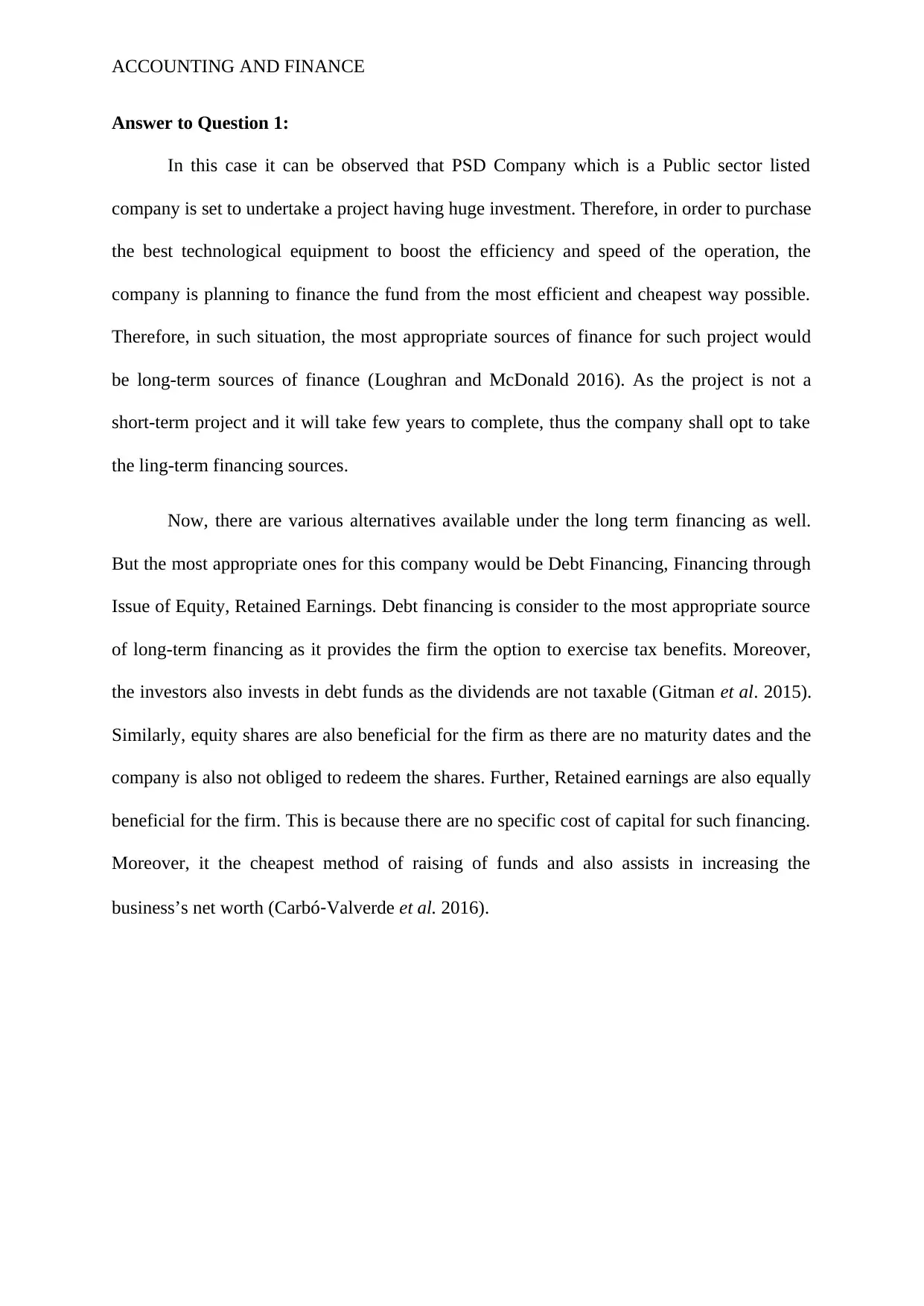
ACCOUNTING AND FINANCE
Answer to Question 1:
In this case it can be observed that PSD Company which is a Public sector listed
company is set to undertake a project having huge investment. Therefore, in order to purchase
the best technological equipment to boost the efficiency and speed of the operation, the
company is planning to finance the fund from the most efficient and cheapest way possible.
Therefore, in such situation, the most appropriate sources of finance for such project would
be long-term sources of finance (Loughran and McDonald 2016). As the project is not a
short-term project and it will take few years to complete, thus the company shall opt to take
the ling-term financing sources.
Now, there are various alternatives available under the long term financing as well.
But the most appropriate ones for this company would be Debt Financing, Financing through
Issue of Equity, Retained Earnings. Debt financing is consider to the most appropriate source
of long-term financing as it provides the firm the option to exercise tax benefits. Moreover,
the investors also invests in debt funds as the dividends are not taxable (Gitman et al. 2015).
Similarly, equity shares are also beneficial for the firm as there are no maturity dates and the
company is also not obliged to redeem the shares. Further, Retained earnings are also equally
beneficial for the firm. This is because there are no specific cost of capital for such financing.
Moreover, it the cheapest method of raising of funds and also assists in increasing the
business’s net worth (Carbó‐Valverde et al. 2016).
Answer to Question 1:
In this case it can be observed that PSD Company which is a Public sector listed
company is set to undertake a project having huge investment. Therefore, in order to purchase
the best technological equipment to boost the efficiency and speed of the operation, the
company is planning to finance the fund from the most efficient and cheapest way possible.
Therefore, in such situation, the most appropriate sources of finance for such project would
be long-term sources of finance (Loughran and McDonald 2016). As the project is not a
short-term project and it will take few years to complete, thus the company shall opt to take
the ling-term financing sources.
Now, there are various alternatives available under the long term financing as well.
But the most appropriate ones for this company would be Debt Financing, Financing through
Issue of Equity, Retained Earnings. Debt financing is consider to the most appropriate source
of long-term financing as it provides the firm the option to exercise tax benefits. Moreover,
the investors also invests in debt funds as the dividends are not taxable (Gitman et al. 2015).
Similarly, equity shares are also beneficial for the firm as there are no maturity dates and the
company is also not obliged to redeem the shares. Further, Retained earnings are also equally
beneficial for the firm. This is because there are no specific cost of capital for such financing.
Moreover, it the cheapest method of raising of funds and also assists in increasing the
business’s net worth (Carbó‐Valverde et al. 2016).
⊘ This is a preview!⊘
Do you want full access?
Subscribe today to unlock all pages.

Trusted by 1+ million students worldwide
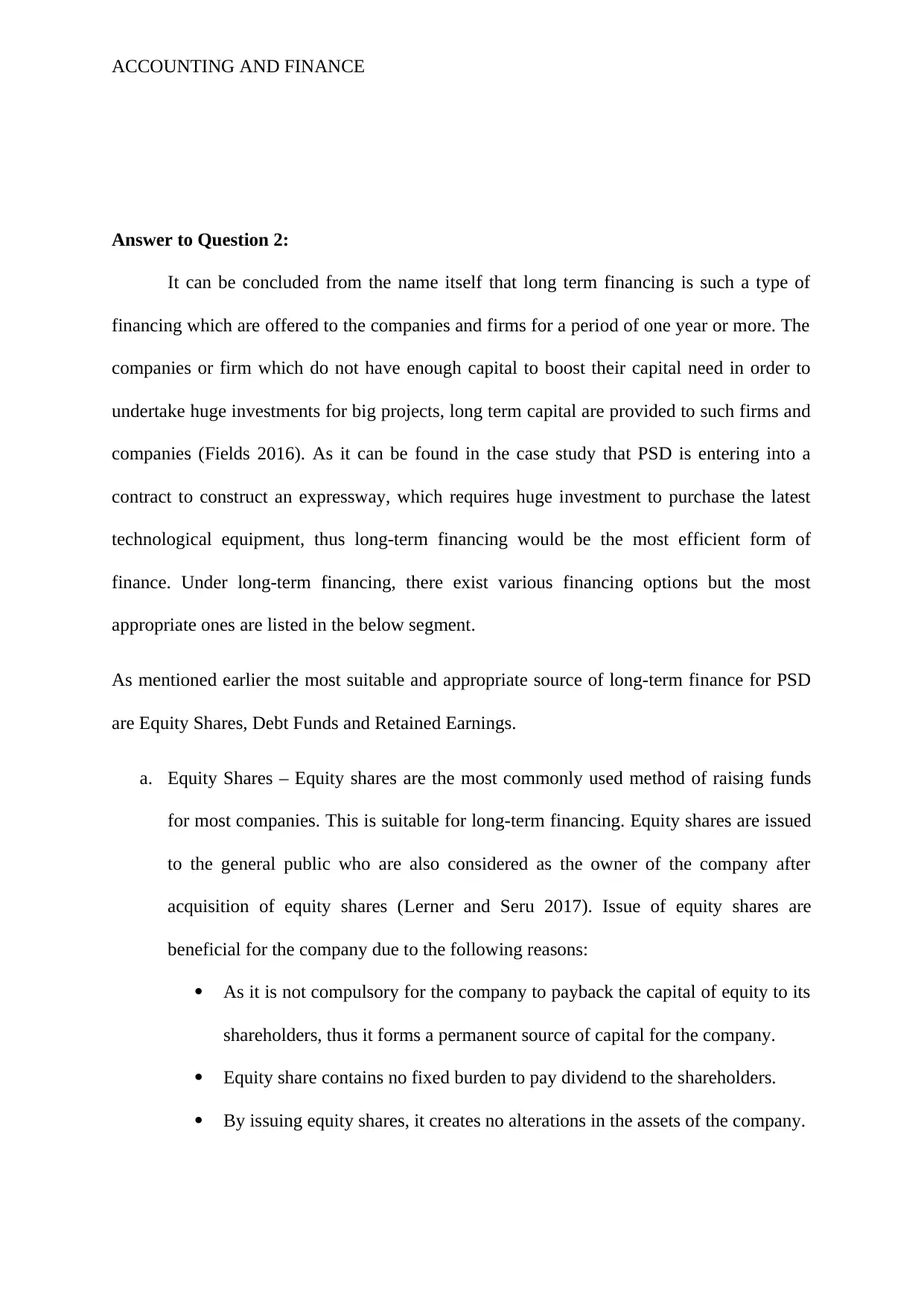
ACCOUNTING AND FINANCE
Answer to Question 2:
It can be concluded from the name itself that long term financing is such a type of
financing which are offered to the companies and firms for a period of one year or more. The
companies or firm which do not have enough capital to boost their capital need in order to
undertake huge investments for big projects, long term capital are provided to such firms and
companies (Fields 2016). As it can be found in the case study that PSD is entering into a
contract to construct an expressway, which requires huge investment to purchase the latest
technological equipment, thus long-term financing would be the most efficient form of
finance. Under long-term financing, there exist various financing options but the most
appropriate ones are listed in the below segment.
As mentioned earlier the most suitable and appropriate source of long-term finance for PSD
are Equity Shares, Debt Funds and Retained Earnings.
a. Equity Shares – Equity shares are the most commonly used method of raising funds
for most companies. This is suitable for long-term financing. Equity shares are issued
to the general public who are also considered as the owner of the company after
acquisition of equity shares (Lerner and Seru 2017). Issue of equity shares are
beneficial for the company due to the following reasons:
As it is not compulsory for the company to payback the capital of equity to its
shareholders, thus it forms a permanent source of capital for the company.
Equity share contains no fixed burden to pay dividend to the shareholders.
By issuing equity shares, it creates no alterations in the assets of the company.
Answer to Question 2:
It can be concluded from the name itself that long term financing is such a type of
financing which are offered to the companies and firms for a period of one year or more. The
companies or firm which do not have enough capital to boost their capital need in order to
undertake huge investments for big projects, long term capital are provided to such firms and
companies (Fields 2016). As it can be found in the case study that PSD is entering into a
contract to construct an expressway, which requires huge investment to purchase the latest
technological equipment, thus long-term financing would be the most efficient form of
finance. Under long-term financing, there exist various financing options but the most
appropriate ones are listed in the below segment.
As mentioned earlier the most suitable and appropriate source of long-term finance for PSD
are Equity Shares, Debt Funds and Retained Earnings.
a. Equity Shares – Equity shares are the most commonly used method of raising funds
for most companies. This is suitable for long-term financing. Equity shares are issued
to the general public who are also considered as the owner of the company after
acquisition of equity shares (Lerner and Seru 2017). Issue of equity shares are
beneficial for the company due to the following reasons:
As it is not compulsory for the company to payback the capital of equity to its
shareholders, thus it forms a permanent source of capital for the company.
Equity share contains no fixed burden to pay dividend to the shareholders.
By issuing equity shares, it creates no alterations in the assets of the company.
Paraphrase This Document
Need a fresh take? Get an instant paraphrase of this document with our AI Paraphraser
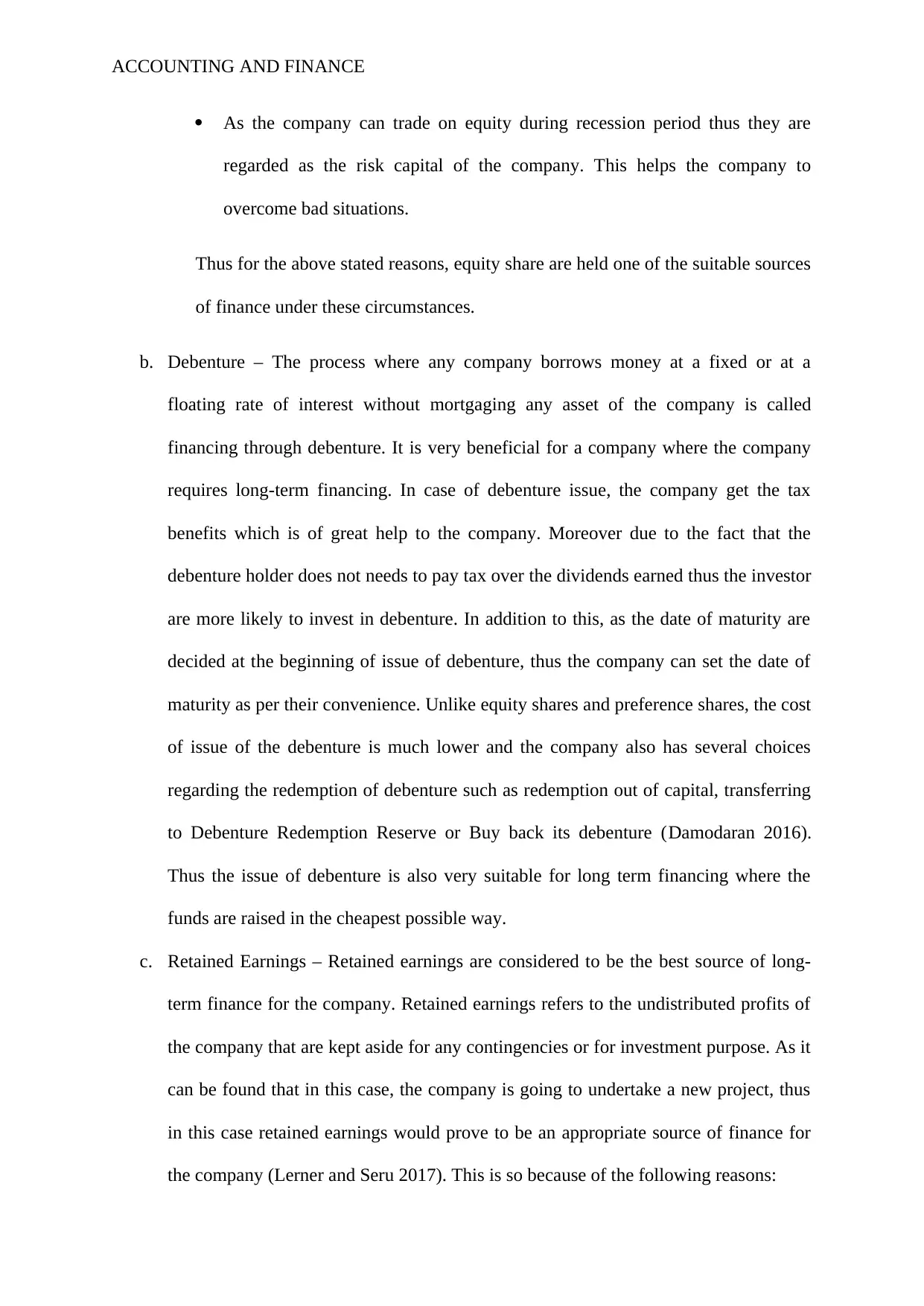
ACCOUNTING AND FINANCE
As the company can trade on equity during recession period thus they are
regarded as the risk capital of the company. This helps the company to
overcome bad situations.
Thus for the above stated reasons, equity share are held one of the suitable sources
of finance under these circumstances.
b. Debenture – The process where any company borrows money at a fixed or at a
floating rate of interest without mortgaging any asset of the company is called
financing through debenture. It is very beneficial for a company where the company
requires long-term financing. In case of debenture issue, the company get the tax
benefits which is of great help to the company. Moreover due to the fact that the
debenture holder does not needs to pay tax over the dividends earned thus the investor
are more likely to invest in debenture. In addition to this, as the date of maturity are
decided at the beginning of issue of debenture, thus the company can set the date of
maturity as per their convenience. Unlike equity shares and preference shares, the cost
of issue of the debenture is much lower and the company also has several choices
regarding the redemption of debenture such as redemption out of capital, transferring
to Debenture Redemption Reserve or Buy back its debenture (Damodaran 2016).
Thus the issue of debenture is also very suitable for long term financing where the
funds are raised in the cheapest possible way.
c. Retained Earnings – Retained earnings are considered to be the best source of long-
term finance for the company. Retained earnings refers to the undistributed profits of
the company that are kept aside for any contingencies or for investment purpose. As it
can be found that in this case, the company is going to undertake a new project, thus
in this case retained earnings would prove to be an appropriate source of finance for
the company (Lerner and Seru 2017). This is so because of the following reasons:
As the company can trade on equity during recession period thus they are
regarded as the risk capital of the company. This helps the company to
overcome bad situations.
Thus for the above stated reasons, equity share are held one of the suitable sources
of finance under these circumstances.
b. Debenture – The process where any company borrows money at a fixed or at a
floating rate of interest without mortgaging any asset of the company is called
financing through debenture. It is very beneficial for a company where the company
requires long-term financing. In case of debenture issue, the company get the tax
benefits which is of great help to the company. Moreover due to the fact that the
debenture holder does not needs to pay tax over the dividends earned thus the investor
are more likely to invest in debenture. In addition to this, as the date of maturity are
decided at the beginning of issue of debenture, thus the company can set the date of
maturity as per their convenience. Unlike equity shares and preference shares, the cost
of issue of the debenture is much lower and the company also has several choices
regarding the redemption of debenture such as redemption out of capital, transferring
to Debenture Redemption Reserve or Buy back its debenture (Damodaran 2016).
Thus the issue of debenture is also very suitable for long term financing where the
funds are raised in the cheapest possible way.
c. Retained Earnings – Retained earnings are considered to be the best source of long-
term finance for the company. Retained earnings refers to the undistributed profits of
the company that are kept aside for any contingencies or for investment purpose. As it
can be found that in this case, the company is going to undertake a new project, thus
in this case retained earnings would prove to be an appropriate source of finance for
the company (Lerner and Seru 2017). This is so because of the following reasons:
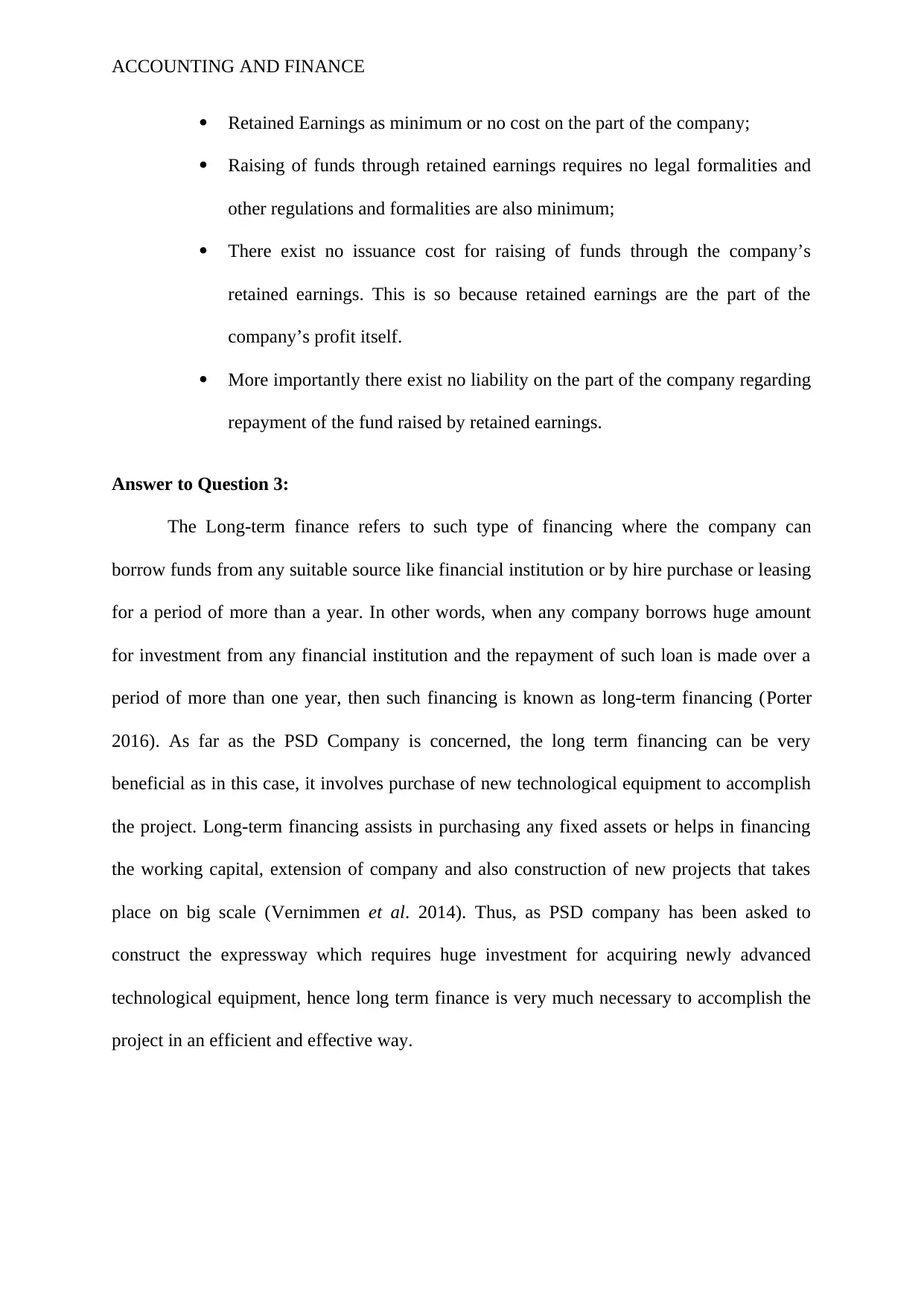
ACCOUNTING AND FINANCE
Retained Earnings as minimum or no cost on the part of the company;
Raising of funds through retained earnings requires no legal formalities and
other regulations and formalities are also minimum;
There exist no issuance cost for raising of funds through the company’s
retained earnings. This is so because retained earnings are the part of the
company’s profit itself.
More importantly there exist no liability on the part of the company regarding
repayment of the fund raised by retained earnings.
Answer to Question 3:
The Long-term finance refers to such type of financing where the company can
borrow funds from any suitable source like financial institution or by hire purchase or leasing
for a period of more than a year. In other words, when any company borrows huge amount
for investment from any financial institution and the repayment of such loan is made over a
period of more than one year, then such financing is known as long-term financing (Porter
2016). As far as the PSD Company is concerned, the long term financing can be very
beneficial as in this case, it involves purchase of new technological equipment to accomplish
the project. Long-term financing assists in purchasing any fixed assets or helps in financing
the working capital, extension of company and also construction of new projects that takes
place on big scale (Vernimmen et al. 2014). Thus, as PSD company has been asked to
construct the expressway which requires huge investment for acquiring newly advanced
technological equipment, hence long term finance is very much necessary to accomplish the
project in an efficient and effective way.
Retained Earnings as minimum or no cost on the part of the company;
Raising of funds through retained earnings requires no legal formalities and
other regulations and formalities are also minimum;
There exist no issuance cost for raising of funds through the company’s
retained earnings. This is so because retained earnings are the part of the
company’s profit itself.
More importantly there exist no liability on the part of the company regarding
repayment of the fund raised by retained earnings.
Answer to Question 3:
The Long-term finance refers to such type of financing where the company can
borrow funds from any suitable source like financial institution or by hire purchase or leasing
for a period of more than a year. In other words, when any company borrows huge amount
for investment from any financial institution and the repayment of such loan is made over a
period of more than one year, then such financing is known as long-term financing (Porter
2016). As far as the PSD Company is concerned, the long term financing can be very
beneficial as in this case, it involves purchase of new technological equipment to accomplish
the project. Long-term financing assists in purchasing any fixed assets or helps in financing
the working capital, extension of company and also construction of new projects that takes
place on big scale (Vernimmen et al. 2014). Thus, as PSD company has been asked to
construct the expressway which requires huge investment for acquiring newly advanced
technological equipment, hence long term finance is very much necessary to accomplish the
project in an efficient and effective way.
⊘ This is a preview!⊘
Do you want full access?
Subscribe today to unlock all pages.

Trusted by 1+ million students worldwide

ACCOUNTING AND FINANCE
Paraphrase This Document
Need a fresh take? Get an instant paraphrase of this document with our AI Paraphraser
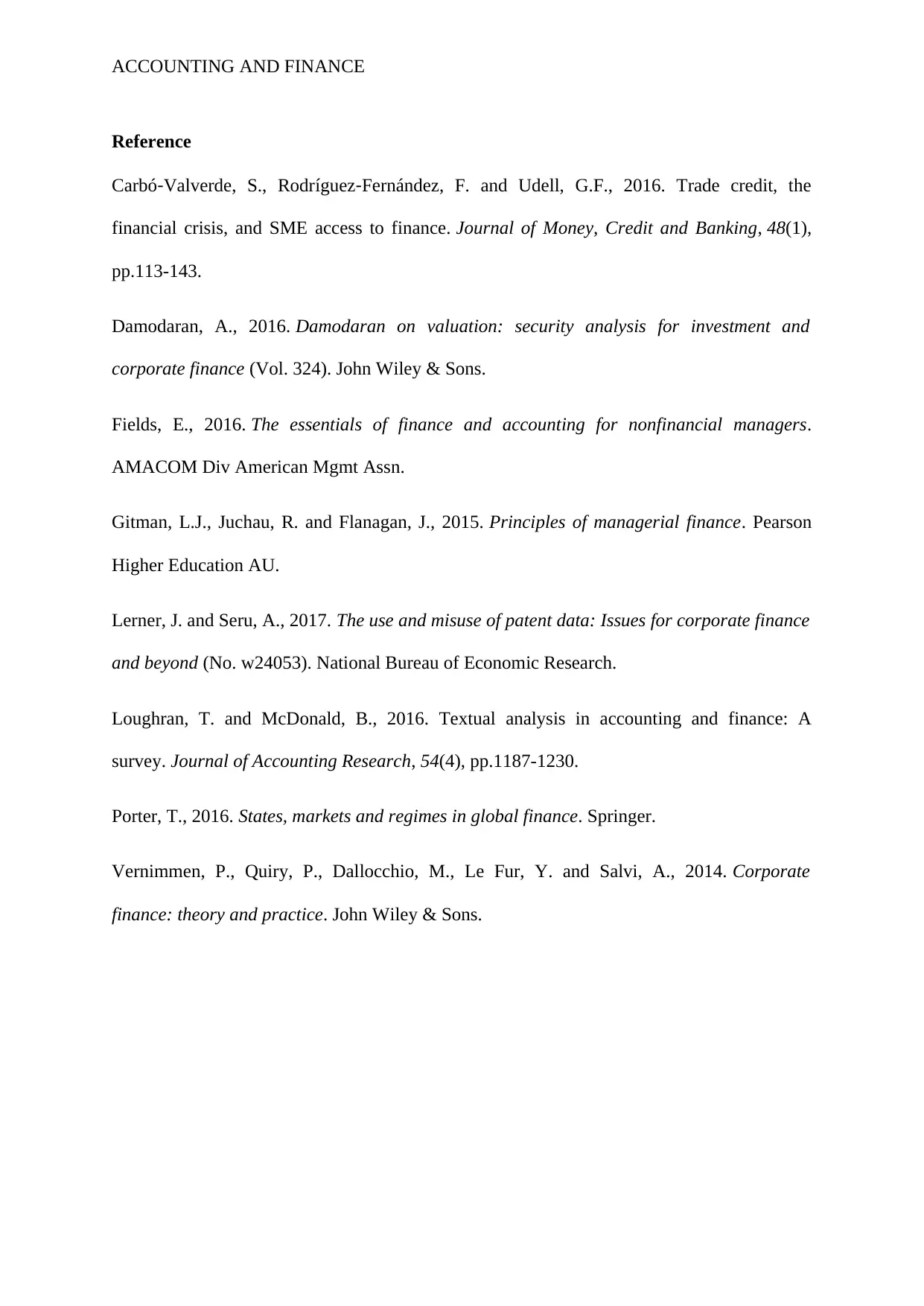
ACCOUNTING AND FINANCE
Reference
Carbó‐Valverde, S., Rodríguez‐Fernández, F. and Udell, G.F., 2016. Trade credit, the
financial crisis, and SME access to finance. Journal of Money, Credit and Banking, 48(1),
pp.113-143.
Damodaran, A., 2016. Damodaran on valuation: security analysis for investment and
corporate finance (Vol. 324). John Wiley & Sons.
Fields, E., 2016. The essentials of finance and accounting for nonfinancial managers.
AMACOM Div American Mgmt Assn.
Gitman, L.J., Juchau, R. and Flanagan, J., 2015. Principles of managerial finance. Pearson
Higher Education AU.
Lerner, J. and Seru, A., 2017. The use and misuse of patent data: Issues for corporate finance
and beyond (No. w24053). National Bureau of Economic Research.
Loughran, T. and McDonald, B., 2016. Textual analysis in accounting and finance: A
survey. Journal of Accounting Research, 54(4), pp.1187-1230.
Porter, T., 2016. States, markets and regimes in global finance. Springer.
Vernimmen, P., Quiry, P., Dallocchio, M., Le Fur, Y. and Salvi, A., 2014. Corporate
finance: theory and practice. John Wiley & Sons.
Reference
Carbó‐Valverde, S., Rodríguez‐Fernández, F. and Udell, G.F., 2016. Trade credit, the
financial crisis, and SME access to finance. Journal of Money, Credit and Banking, 48(1),
pp.113-143.
Damodaran, A., 2016. Damodaran on valuation: security analysis for investment and
corporate finance (Vol. 324). John Wiley & Sons.
Fields, E., 2016. The essentials of finance and accounting for nonfinancial managers.
AMACOM Div American Mgmt Assn.
Gitman, L.J., Juchau, R. and Flanagan, J., 2015. Principles of managerial finance. Pearson
Higher Education AU.
Lerner, J. and Seru, A., 2017. The use and misuse of patent data: Issues for corporate finance
and beyond (No. w24053). National Bureau of Economic Research.
Loughran, T. and McDonald, B., 2016. Textual analysis in accounting and finance: A
survey. Journal of Accounting Research, 54(4), pp.1187-1230.
Porter, T., 2016. States, markets and regimes in global finance. Springer.
Vernimmen, P., Quiry, P., Dallocchio, M., Le Fur, Y. and Salvi, A., 2014. Corporate
finance: theory and practice. John Wiley & Sons.
1 out of 8
Related Documents
Your All-in-One AI-Powered Toolkit for Academic Success.
+13062052269
info@desklib.com
Available 24*7 on WhatsApp / Email
![[object Object]](/_next/static/media/star-bottom.7253800d.svg)
Unlock your academic potential
Copyright © 2020–2025 A2Z Services. All Rights Reserved. Developed and managed by ZUCOL.





